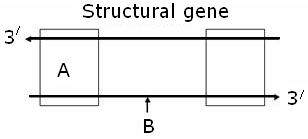Biology:2008:CBSE:[ Delhi ]:Set-I
To Access the full content, Please Purchase
-
Q1
What causes speciation according to Hugo de Vries?
Marks:1View AnswerAnswer:
Mutation
-
Q2
When and why do some animals like frogs hibernate?
Marks:1View AnswerAnswer:
To avoid unfavourable conditions during winter.
-
Q3
List any two economically important products for humans obtained from Apis indica.
Marks:1View AnswerAnswer:
a. Honey,
b. Beeswax. -
Q4
Name the Indian variety of rice patented by an American company.
Marks:1View AnswerAnswer:
Basmati.
-
Q5
What role do microphages play in providing immunity to humans?
Marks:1View AnswerAnswer:
They can phagocytose and destroy invading pathogens.
-
Q6
Name the world’s most problematic aquatic weed. What is the nature of the water body in which the weeds grow abundantly?
Marks:1View AnswerAnswer:
Water hyacinth (Eicchornia).It grows in standing water.
-
Q7
Name the parts ‘A’ and ‘B’ of the transcription unit given below.
 Marks:1View Answer
Marks:1View AnswerAnswer:
‘A’ – Promoter
‘B’ – Coding Strand -
Q8
What is the major difference you observe in the offspring’s produced by asexual reproduction and in the progeny produced by sexual reproduction?
Marks:1View AnswerAnswer:
The offsprings produced by asexual reproduction are identical(clones) while in the case of sexual reproduction, they are not identical.
-
Q9
The flower of brinjal is referred to as chasmogamous while that of beans is cleistogamous. How are they different from each others?
Marks:2View AnswerAnswer:
Chasmogamous flowers have exposed anthers and stigma while cleistogamous flowers do not open at all.
-
Q10
Name the interaction in each of the following:
(a) Cuckoo lays her eggs in the crow's nest.
(b) Orchid grows on a mango tree.
(c) Ticks live on the skin of dogs.
(d) Sea anemone is often found on the shell of hermit crab.Marks:2View AnswerAnswer:
a. Brood parasitism
b. commensalism
c. Ecto-parasitism
d. Commensalism



